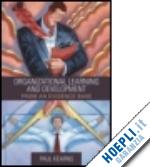1.Developing mature organizations for societal value 2.The evaluation challenge - theory and practice 3.Making a convincing case for the strategic value of OL&D 4.Learning design 5.Strategic OL&D is integral to business strategy 6.The role of OL&D in a mature organization 7.Designing and developing the whole system Chapter 1 Developing mature organizations for societal value - Milton Friedman said a company’s only social responsibility is to make a profit - he was wrong - its social responsibility is to create as much societal value as possible from its capital and that includes human capital. What has been holding society back is the failure of the organizational learning and development profession’s inability to put a value on learning and development. All organizations need to embark on a developmental journey along the Organizational Learning Maturity Scale if they are to make the most of their human capital. Chapter 2 The evaluation challenge - theory and practice -the theory of evaluation is very simple. Start with a measure of where you are - the baseline - and check again afterwards that there has been some improvement. If it is that simple why do OL&D practitioners refuse to see it that way? Evaluation of learning has never been used to full effect in organizations because of ignorance, resistance and conventional accounting methods that only measure the cost of learning, not the benefits. Chapter 3 Making a convincing case for the value of OL&D - all learning and development can be linked to tangible value - some of it is basic value - the things the organization needs to operate and some of it is added value - improving the organization. The clearest business case comes from adapting conventional ratios, such as ROI to reveal the true value of learning. Chapter 4 Learning design - sheep dip and scattergun training are completely out-moded methods. If you want to get the best value out of the way your people learn then learning has to be designed with that end in mind. Each human being is a unique individual and will learn best when the method suits them. Coaching and talent management might sound like better approaches but are they? All learning has to be designed to produce clear evidence that it has been effective. Chapter 5Strategic OL&D is integral to business strategy - strategic planning frameworks have not been designed to incorporate the competitive advantages of being a learning organization. Ensuring that learning is factored into business plans is a highly skilled job that can only be handled by an OL&D professional. Training budgets and training plans are never going to be strategic unless they are totally integrated. Chapter 6The role of OL&D in a mature organization - the role of the OL&D Professional is a brand new role because it is evidence-based. These professionals can only be as effective as the maturity of the people and the organization they work with. Executives and managers have to be educated to raise their own game of staff development and talent management to match the professional requirements of a learning organization. Chapter 7Designing and developing the whole system - the most mature organizations are whole systems. Whole systems are the most effective organizations and offer the highest value to shareholders, employees and society as a whole. This is organizational nirvana and it can be achieved by the majority of organizations once they know what is required.











